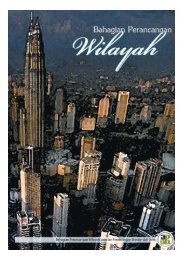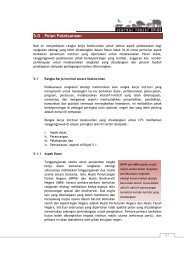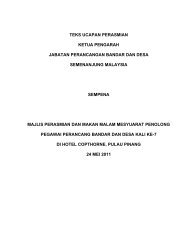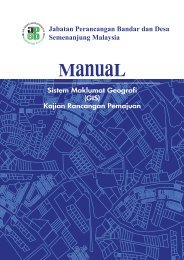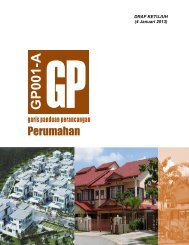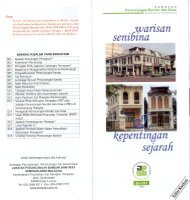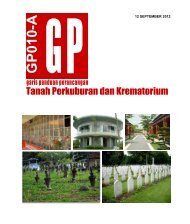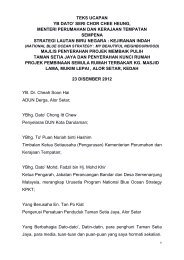Jabatan Perancangan Bandar Dan Desa Semenanjung Malaysia ...
Jabatan Perancangan Bandar Dan Desa Semenanjung Malaysia ...
Jabatan Perancangan Bandar Dan Desa Semenanjung Malaysia ...
You also want an ePaper? Increase the reach of your titles
YUMPU automatically turns print PDFs into web optimized ePapers that Google loves.
<strong>Jabatan</strong> <strong>Perancangan</strong> <strong>Bandar</strong> <strong>Dan</strong> <strong>Desa</strong> <strong>Semenanjung</strong> <strong>Malaysia</strong><br />
Kementerian Perumahan <strong>Dan</strong> Kerajaan Tempatan
Jane Jacobs, then chairperson of a civic<br />
group in Greenwich Village, at a press<br />
conference in 1961.<br />
She was a strong critic of urban<br />
renewal policies and urban<br />
planning thought in the 1950’s<br />
She observed street life and<br />
neighborhoods in American<br />
cities and made analysis of what<br />
made a city work or did not work<br />
She provided recommendations<br />
on how government actions can<br />
help a city regenerate and thrive
Cover of the book<br />
The author Jane Jacobs<br />
The book is written in 4 parts with 22 Chapters :<br />
Part 1: The Peculiar Nature of Cities<br />
Part 2: The Conditions for City Diversity<br />
Part 3: Forces of Decline and Regeneration<br />
Part 4: Different Tactics
PART ONE:<br />
Sidewalks<br />
Parks<br />
Neighborhood
Sidewalks<br />
Safety<br />
Contact<br />
Assimilating children<br />
Sidewalks must be bordered by<br />
buildings so that residents and<br />
shopkeepers provide surveillance and<br />
there will be people using the<br />
sidewalks at all times, and parents can<br />
keep an eye on children from windows
Neighborhood Park<br />
When parks are not used they<br />
become dangerous<br />
A successful park is bordered by<br />
buildings with people walking<br />
through
Effective Neighborhoods<br />
Lively and interesting streets<br />
Continuous network<br />
Parks,squares and public building
PART TWO : THE CONDITIONS FOR DIVERSITY<br />
Diversity is vital for lively cities<br />
A mixture and combination of<br />
uses make up the diversity of<br />
cities
Four conditions are necessary to<br />
generate diversity in a city’s streets<br />
and districts:
Districts with singular function<br />
suffers from extreme time<br />
imbalance among its uses.<br />
An example she observed was<br />
Lower Manhattan, New York<br />
embracing Wall Street with its<br />
financial, law and insurance<br />
offices, the city municipal<br />
offices, state and federal offices<br />
and other work complexes.<br />
During the day, especially at<br />
lunchtime, the city is very<br />
active. After five thirty and on<br />
weekends, there is a deathlike<br />
stillness and dullness.<br />
There is inadequate eating<br />
places, clothing shops, theatres<br />
and other cultural opportunities.
Most effective would be having large<br />
numbers of tourists at all times<br />
New attractions which are attractive to<br />
tourists would have to be planned<br />
She suggested the regeneration of the<br />
old waterfront, a marine museum, and<br />
inexpensive opera and theatre, café and<br />
restaurants
Blocks of buildings<br />
must be short
The Self Destruction of Diversity<br />
Prosperity or popularity<br />
of a place does not last<br />
forever<br />
Duplication of most<br />
profitable use, e.g.<br />
restaurants, leads to<br />
intense competition<br />
The least competitive<br />
closes down, leading to<br />
stagnation and decline of<br />
area<br />
Deserted by people<br />
looking for other uses<br />
Solution to decline is to<br />
deliberately zone the area<br />
for other uses e.g. public<br />
buildings
Border vacuums<br />
refer to<br />
developments<br />
planned next to an<br />
area for<br />
infrastructure and<br />
public facilities<br />
such as railroad<br />
tracks, waterfronts,<br />
big-city university<br />
campuses, express<br />
ways, civic<br />
centres, large<br />
hospital grounds<br />
and large parks
Resettling slums<br />
requires great<br />
amounts of public<br />
money<br />
Resettlement of<br />
slums is just like<br />
shifting the slums<br />
from here to there<br />
Sadly destroys the<br />
neighborhoods<br />
where constructive<br />
and improving<br />
communities exist
Gradual Money and Cataclysmic Money<br />
Three principal kinds of money finance and shape most of<br />
residential and business properties in cities.<br />
First, is credit extended by conventional, nongovernmental<br />
lending institutions<br />
Second, money provided by the government<br />
Third, money that comes from investment<br />
Each does its part in financing city property changes<br />
The kind of money for building upon and supplementing<br />
what exists is gradual money, but this has been lacking<br />
Cataclysmic money pours into an area in concentrated<br />
form producing drastic changes, such as large-scale<br />
clearance and rebuilding<br />
To Jacobs, this is unacceptable as money for city building<br />
should bring about continual, gentler change rather than<br />
violent cataclysms.
Subsidizing dwellings<br />
Attrition (reduction) of motor vehicles<br />
Visual order: its limitations and possibilities<br />
Salvaging projects<br />
Governing and planning districts
Subsidizing dwellings<br />
High population in cities. The poor<br />
cannot afford adequate housing<br />
Government has to take over<br />
housing responsibility<br />
Tenants pay subsidized rents, based<br />
on income level<br />
When incomes increase, tenants are<br />
not asked to leave, but rents would<br />
be adjusted<br />
Let them own house gradually<br />
As a result, diversity is enhanced by<br />
them remaining
Attrition (reduction) of motor vehicles<br />
Planning accommodates automobiles through street<br />
widening, route changes and new bridges<br />
Cities need multiplicity of choice of transportation because<br />
centers of trade and commerce<br />
Pedestrians and automobiles have to co-exist within cities<br />
Widening sidewalks for pedestrians and reducing<br />
roadbeds for automobiles automatically reduce car use<br />
and traffic congestion
Visual order: its limitations and possibilities<br />
Streets represent our visual views of<br />
cities<br />
They need some sort of visual<br />
interruptions or they look like they<br />
are endless<br />
Introduce visual irregularities and<br />
interruptions into the city scene with<br />
art and historical buildings which is<br />
synonym to the locality
Salvaging Project<br />
Most urgent projects that need salvaging<br />
are low income housing<br />
Cities should hold their population through<br />
lively, well-watched continuously used<br />
public spaces allowing easier and natural<br />
supervision of children<br />
Inadequate mix-uses is precisely one of the<br />
causes of deadness, danger and plain<br />
inconvenience<br />
Horizontal structures in city housing work<br />
better than vertical structures for<br />
supervision of children
Governing and Planning<br />
Districts<br />
The Authority members must deal with<br />
large city populations and plan for<br />
diversity and vitality<br />
Planners must promote a continuous<br />
network of local street neighborhoods<br />
Users and informal proprietors can be<br />
counted on to keep the public spaces of<br />
the city safe, and in handling<br />
strangers, and in keeping casual tabs on<br />
children in places that are public
Jane Jacob’s view of city planning:<br />
City planning, like the life sciences of biology and<br />
medicine, deals with problems referred to as problems of<br />
organized complexity<br />
These problems involve numerous problems interrelated to<br />
an organic whole<br />
Ebenezer Howard’s Garden City concept and Le Corbusier’s<br />
Radiant City vision are too simplistic to form the basis for city<br />
planning<br />
Planners need to have a better understanding of the working<br />
and problems of the cities in order to help cities
Reviewing Jane Jacobs’ book has been a<br />
challenging task<br />
The contents are intensive and extensive, and<br />
requires several readings for clarity<br />
The book was written in the early 1960’s about<br />
planning policies and practices in the 1950’s<br />
taking place in large American cities, in<br />
particular New York<br />
Unfamiliarity with the time and the places make<br />
it difficult to have a deeper understanding of the<br />
issues involved
Jane writes passionately with intimate knowledge<br />
of the cities and planning practices of that time<br />
She analyzes the situation from different<br />
viewpoints - social, economic, visual, political –<br />
based on her diverse educational background<br />
and work as a journalist<br />
The book is highly recommended as it contains<br />
many useful ideas on town planning and<br />
development which is still relevant today as it<br />
was fifty years ago.
the team:<br />
lilian ho yin chan<br />
kalsom yop mohd kasim<br />
vikneswaren a/l jayasivam<br />
noraziah abd aziz<br />
norhayati abu bakar<br />
azliza mohamed<br />
norhasliza nazail<br />
shahrin amir sharifuddin<br />
azmi husien<br />
yusnaim abd rani<br />
fairulwati farok<br />
sas2772@yahoo.com




